2013 SMART FORTWO COUPE ELECTRIC DRIVE battery
[x] Cancel search: batteryPage 166 of 218

Vehicle
Problem Possible causes/consequences and
0001 Solutions
0004
The red 12-V-
battery
indicator lamp
illuminates
while driving
or does not go
out after the
drive system is
started. The 12-V-battery is not being charged.
X
Stop the vehicle immediately in a safe location.
X Do not continue to drive.
X Switch off the drive system.
X Engage the parking brake when leaving the vehicle.
X Contact Roadside Assistance or an authorized electric drive
smart center. 0002
The yellow
high-voltage
battery
warning lamp
comes on while
driving. There may be a malfunction in the high-voltage system.
Contact an authorized electric drive smart center immediately
and have the high-voltage system checked.
0001
The high‑beam
headlamp
indicator lamp
does not
illuminate
when the
high‑beam
headlamps are
switched on or
when using the
high‑beam
flasher. The high‑beam headlamp indicator lamp has failed.
X
Have the high‑beam headlamp indicator lamp checked at an
authorized electric drive smart center. 0003
The low‑beam
headlamp
indicator lamp
does not
illuminate
when the
low‑beam
headlamps are
switched on. The low‑beam headlamp indicator lamp has failed.
X
Have the low‑beam headlamp indicator lamp checked at an
authorized electric drive smart center. 164
What to do if ...>> Practical hints.
Page 167 of 218
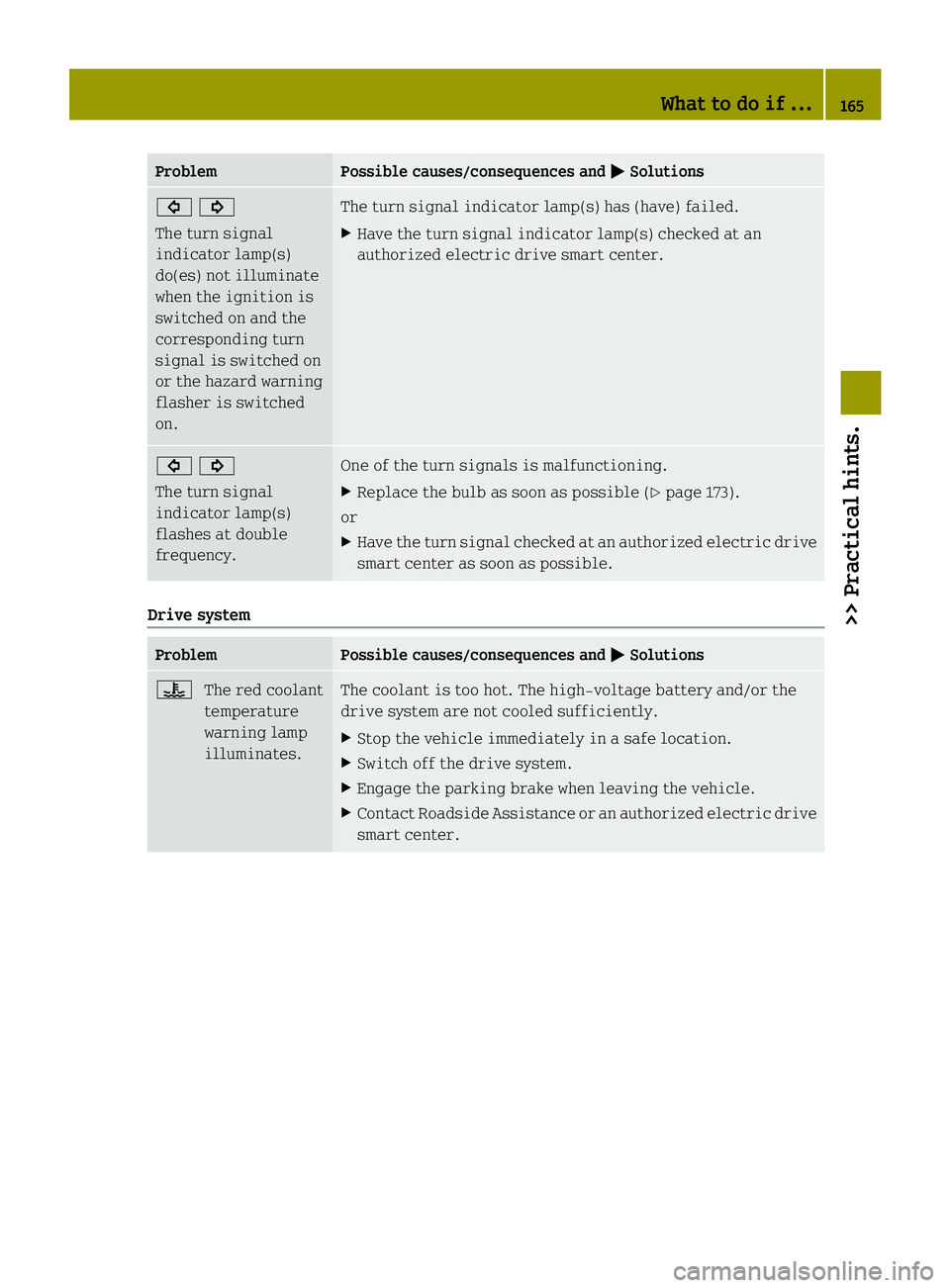
Problem Possible causes/consequences and
0001 Solutions
00030002
The turn signal
indicator lamp(s)
do(es) not illuminate
when the ignition is
switched on and the
corresponding turn
signal is switched on
or the hazard warning
flasher is switched
on. The turn signal indicator lamp(s) has (have) failed.
X
Have the turn signal indicator lamp(s) checked at an
authorized electric drive smart center. 00030002
The turn signal
indicator lamp(s)
flashes at double
frequency. One of the turn signals is malfunctioning.
X
Replace the bulb as soon as possible (Y page 173).
or
X Have the turn signal checked at an authorized electric drive
smart center as soon as possible. Drive system
Problem Possible causes/consequences and
0001 Solutions
0005
The red coolant
temperature
warning lamp
illuminates. The coolant is too hot. The high-voltage battery and/or the
drive system are not cooled sufficiently.
X
Stop the vehicle immediately in a safe location.
X Switch off the drive system.
X Engage the parking brake when leaving the vehicle.
X Contact Roadside Assistance or an authorized electric drive
smart center. What to do if ...
165>> Practical hints. Z
Page 172 of 218
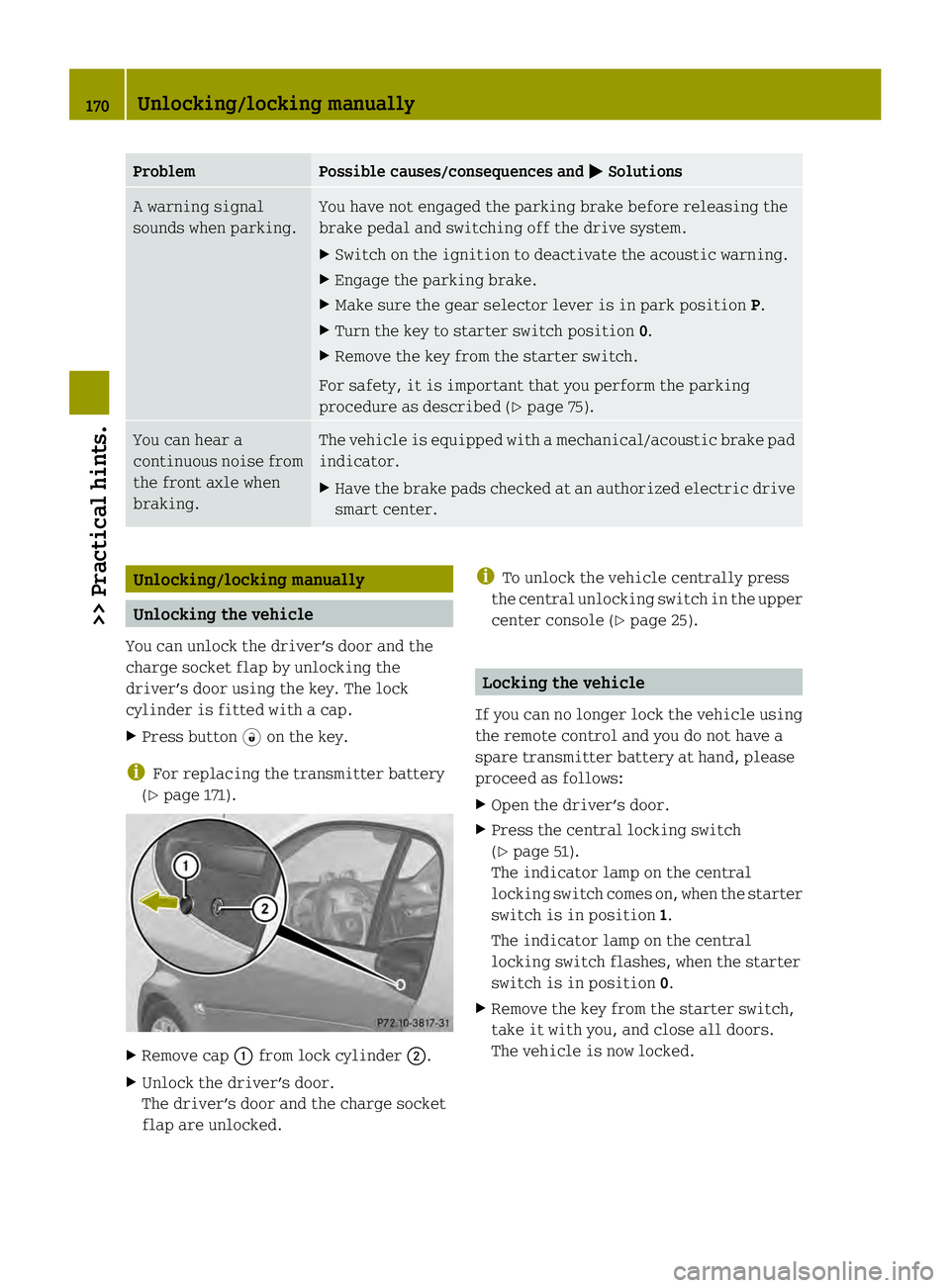
Problem Possible causes/consequences and
0001 Solutions
A warning signal
sounds when parking. You have not engaged the parking brake before releasing the
brake pedal and switching off the drive system.
X
Switch on the ignition to deactivate the acoustic warning.
X Engage the parking brake.
X Make sure the gear selector lever is in park position P.
X Turn the key to starter switch position 0.
X Remove the key from the starter switch.
For safety, it is important that you perform the parking
procedure as described (Y page 75).You can hear a
continuous noise from
the front axle when
braking. The vehicle is equipped with a mechanical/acoustic brake pad
indicator.
X
Have the brake pads checked at an authorized electric drive
smart center. Unlocking/locking manually
Unlocking the vehicle
You can unlock the driver’s door and the
charge socke tflap by unlocking the
driver’s door using the key. The lock
cylinder is fitted with a cap.
X Press button 0006on the key.
i For replacing the transmitter battery
(Y page 171). X
Remove cap 0002from lock cylinder 0003.
X Unlock the driver’s door.
The driver’s door and the charge socket
flap are unlocked. i
To unlock the vehicle centrally press
the central unlocking switch in the upper
center console (Y page 25). Locking the vehicle
If you can no longer lock the vehicle using
the remote control and you do not have a
spare transmitter battery at hand, please
proceed as follows:
X Open the driver’s door.
X Press the central locking switch
(Y page 51).
The indicator lamp on the central
locking switch comes on, when the starter
switch is in position 1.
The indicator lamp on the central
locking switch flashes, when the starter
switch is in position 0.
X Remove the key from the starter switch,
take it with you, and close all doors.
The vehicle is now locked. 170
Unlocking/locking manually>> Practical hints.
Page 173 of 218

Closing the rear soft top
If the rear soft top does not lock properly
after being closed, proceed as follows:
X Stop the vehicle in a safe location.
X Engage the parking brake.
X Make sure the key is in starter switch
position 1.
X Fold up the rear soft top completely.
The rear soft top stops in the unlocked
position.
X Within one minute, press and hold symbol
0003 on the retractable soft top switch
for 15 seconds twice.
The rear soft top closes the locking
hooks.
X Close the retractable soft top
completely.
X Have the rear soft top checked at an
authorized electric drive smart center. Replacing transmitter battery
Notes
The remot econtrol’s transmitter battery is
almost spent when the turn signals flash
rapidly nine times in a row when locking
the vehicle.
i If you do not replace the transmitter
battery, after about 100 more times you
will no longer be able to lock or unlock
the vehicle using the remote control.
X Replace the transmitter battery.
or
X Have the transmitter battery replaced at
an authorized electric drive smart
center. G
WARNING
Batteries contain poisonous and corrosive
substances. Therefore keep the batteries
out of reach of children.
If a battery is swallowed, seek medical help
immediately. Batteries contain materials that can harm
the environment if disposed of improperly.
Recycling of batteries is the preferred
method of disposal. Many states/provinces
require sellers of batteries to accept old
batteries for recycling.
Replacing battery
Replacement battery: CR 2016 button cell
! Replace the remote control’s
transmitter battery every two years at
the latest. Otherwise there is a danger of
leakage. The remote control could be
damaged. X
Insert a suitable object such as a coin
into the slot at the eyelet of the key
housing.
X Carefully turn the coin until key housing
top half 0002is unlatched.
X Open key housing top half 0002to the side. X
Remove transmitter battery 0003from the
board. Replacing transmitter battery
171>> Practical hints. Z
Page 174 of 218

!
Check the polarity when inserting the
new transmitter battery. You could
otherwise damage parts of the electrical
system. When inserting the batteries,
make sure they are clean and free of lint.
X Insert the new transmitter battery.
X Press both halves of the key housing
together again.
X Check the operation of the remote
control. Replacing bulbs
About replacing bulbs
Safe vehicle operation depends on proper
exterior lighting and signaling. It is
therefore essential that all bulbs and lamp
assemblies are in good working order at all
times.
Correct headlamp adjustment is extremely
important. Have headlamps checked and
readjusted at regular intervals and when a
bulb has been replaced. Contact an
authorized electric drive smart center for
headlamp adjustment. G
WARNING
Bulbs and bulb sockets can be very hot.
Allow the lamp to cool down before changing
a bulb. Otherwise you could be burned if you
touch them.
Keep bulbs out of the reach of children.
Halogen lamps contain pressurized gas. A
bulb can explode if you:
R touch or move it when hot
R drop the bulb
R scratch the bulb
Wear eye and hand protection.
i If the headlamps or front fog lamps* are
fogged up on the inside as a result of
high humidity, driving the vehicle a
distance with the lights on should clear
up the fogging. Notes on bulb replacement:
R
Only use bulbs of the same type and with
the specified watt rating.
R Switch the lights off before replacing a
bulb to prevent short circuits.
R Always use aclean lint-free cloth when
handling bulbs.
R Your hands should be dry and free of oil
and grease.
R Avoid touching the glass of the bulb with
bare fingers.
R If the newly installed bulb does not come
on, contact an authorized electric drive
smart center.
R Have the bulbs for the front fog lamps*
and the LED daytime running lamps*
replaced at an authorized electric drive
smart center. 172
Replacing bulbs>> Practical hints.
* optional
Page 185 of 218
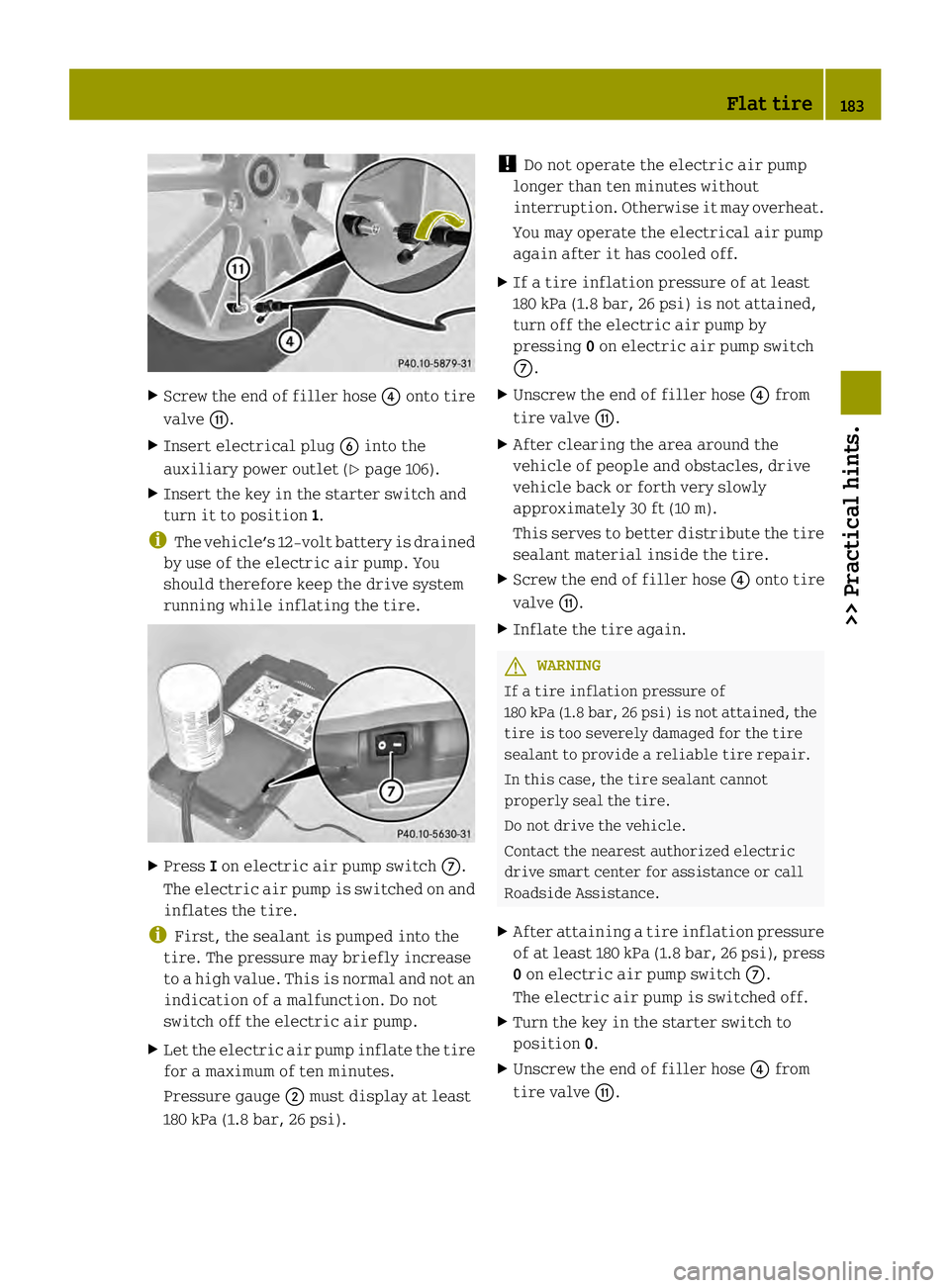
X
Screw the end of filler hose 002Aonto tire
valve 001D.
X Insert electrical plug 0029into the
auxiliary power outlet (Y page 106).
X Insert the key in the starter switch and
turn it to position 1.
i The vehicle’s 12‑volt battery is drained
by use of the electric air pump. You
should therefore keep the drive system
running while inflating the tire. X
Press Ion electric air pump switch 0018.
The electric air pump is switched on and
inflates the tire.
i First, the sealant is pumped into the
tire. The pressure may briefly increase
to a high value. This is normal and not an
indication of a malfunction. Do not
switch off the electric air pump.
X Let the electric air pump inflate the tire
for a maximum of ten minutes.
Pressure gauge 0003must display at least
180 kPa (1.8 bar, 26 psi). !
Do not operate the electric air pump
longer than ten minutes without
interruption. Otherwise it may overheat.
You may operate the electrical air pump
again after it has cooled off.
X If a tire inflation pressure of at least
180 kPa (1.8 bar, 26 psi) is not attained,
turn off the electric air pump by
pressing 0on electric air pump switch
0018.
X Unscre wthe end of filler hose 002Afrom
tire valve 001D.
X After clearing the area around the
vehicle of people and obstacles, drive
vehicle back or forth very slowly
approximately 30 ft (10 m).
This serves to better distribute the tire
sealant material inside the tire.
X Screw the end of filler hose 002Aonto tire
valve 001D.
X Inflate the tire again. G
WARNING
If a tire inflation pressure of
180 kPa (1.8 bar, 26 psi) is not attained, the
tire is too severely damaged for the tire
sealant to provide a reliable tire repair.
In this case, the tire sealant cannot
properly seal the tire.
Do not drive the vehicle.
Contact the nearest authorized electric
drive smart center for assistance or call
Roadside Assistance.
X After attaining a tire inflation pressure
of at least 180 kPa (1.8 bar, 26 psi), press
0on electric air pump switch 0018.
The electric air pump is switched off.
X Turn the key in the starter switch to
position 0.
X Unscrew the end of filler hose 002Afrom
tire valve 001D. Flat tire
183>> Practical hints. Z
Page 187 of 218
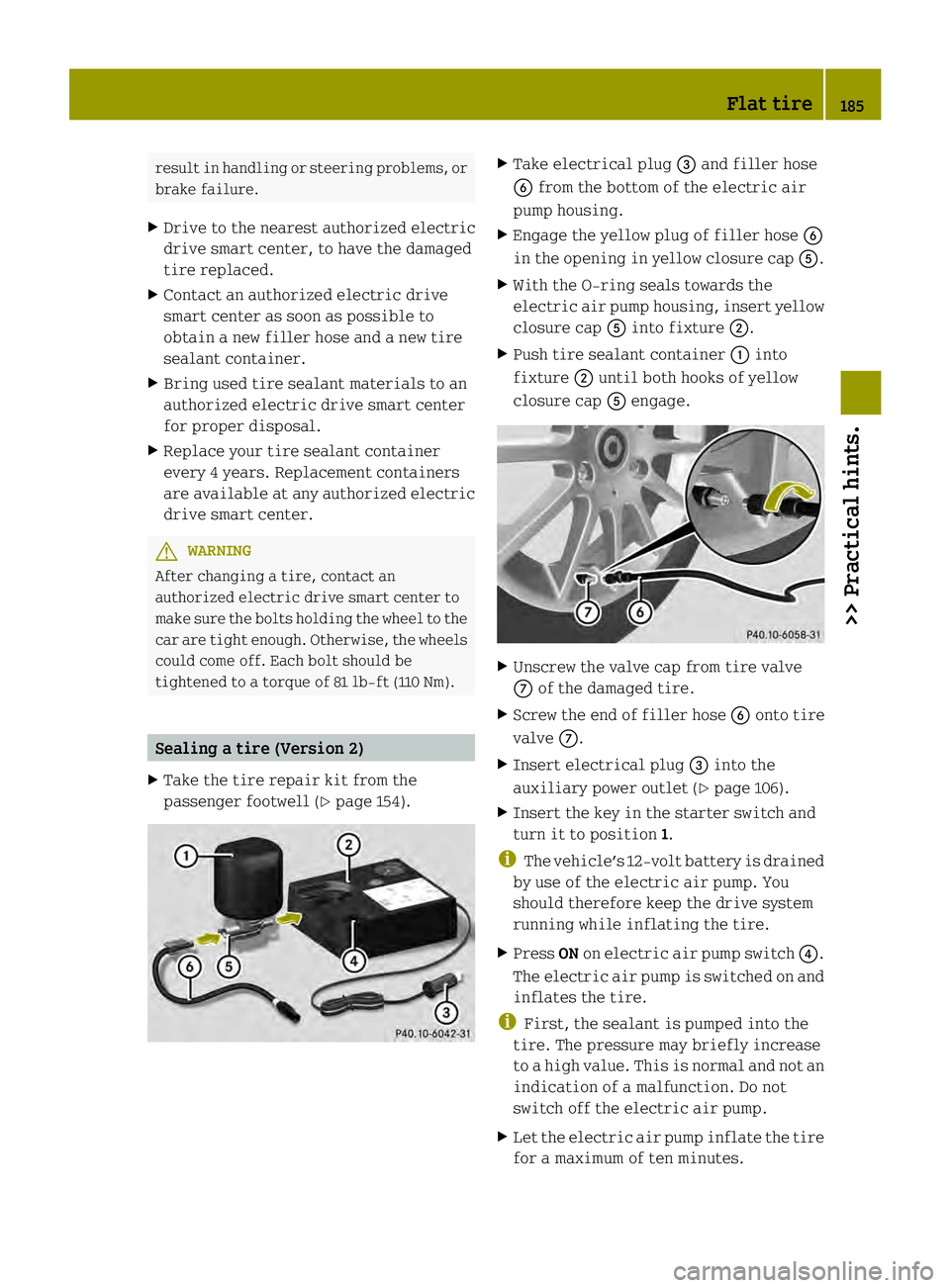
result in handlin
gor steering problems, or
brake failure.
X Drive to the nearest authorized electric
drive smart center, to have the damaged
tire replaced.
X Contact an authorized electric drive
smart center as soon as possible to
obtain a new filler hose and a new tire
sealant container.
X Bring used tire sealant materials to an
authorized electric drive smart center
for proper disposal.
X Replace your tire sealant container
every 4 years. Replacement containers
are available at any authorized electric
drive smart center. G
WARNING
After changing a tire, contact an
authorized electric drive smart center to
make sure the bolts holding the wheel to the
car are tight enough .Otherwise, the wheels
could come off. Each bolt should be
tightened to a torque of 81 lb‑ft (110 Nm). Sealing a tire (Version 2)
X Take the tire repair kit from the
passenger footwell (Y page 154). X
Take electrical plug 002Band filler hose
0029 from the bottom of the electric air
pump housing.
X Engage the yello wplug of filler hose 0029
in the opening in yellow closure cap 0028.
X With the O-ring seals towards the
electric air pump housing, insert yellow
closure cap 0028into fixture 0003.
X Push tire sealant container 0002into
fixture 0003until both hooks of yellow
closure cap 0028engage. X
Unscrew the valve cap from tire valve
0018 of the damaged tire.
X Screw the end of filler hose 0029onto tire
valve 0018.
X Insert electrical plug 002Binto the
auxiliary power outlet (Y page 106).
X Insert the key in the starter switch and
turn it to position 1.
i The vehicle’s 12‑volt battery is drained
by use of the electric air pump. You
should therefore keep the drive system
running while inflating the tire.
X Press ONon electric air pump switch 002A.
The electric air pump is switched on and
inflates the tire.
i First, the sealant is pumped into the
tire. The pressure may briefly increase
to a high value. This is normal and not an
indication of a malfunction. Do not
switch off the electric air pump.
X Let the electric air pump inflate the tire
for a maximum of ten minutes. Flat tire
185>> Practical hints. Z
Page 191 of 218
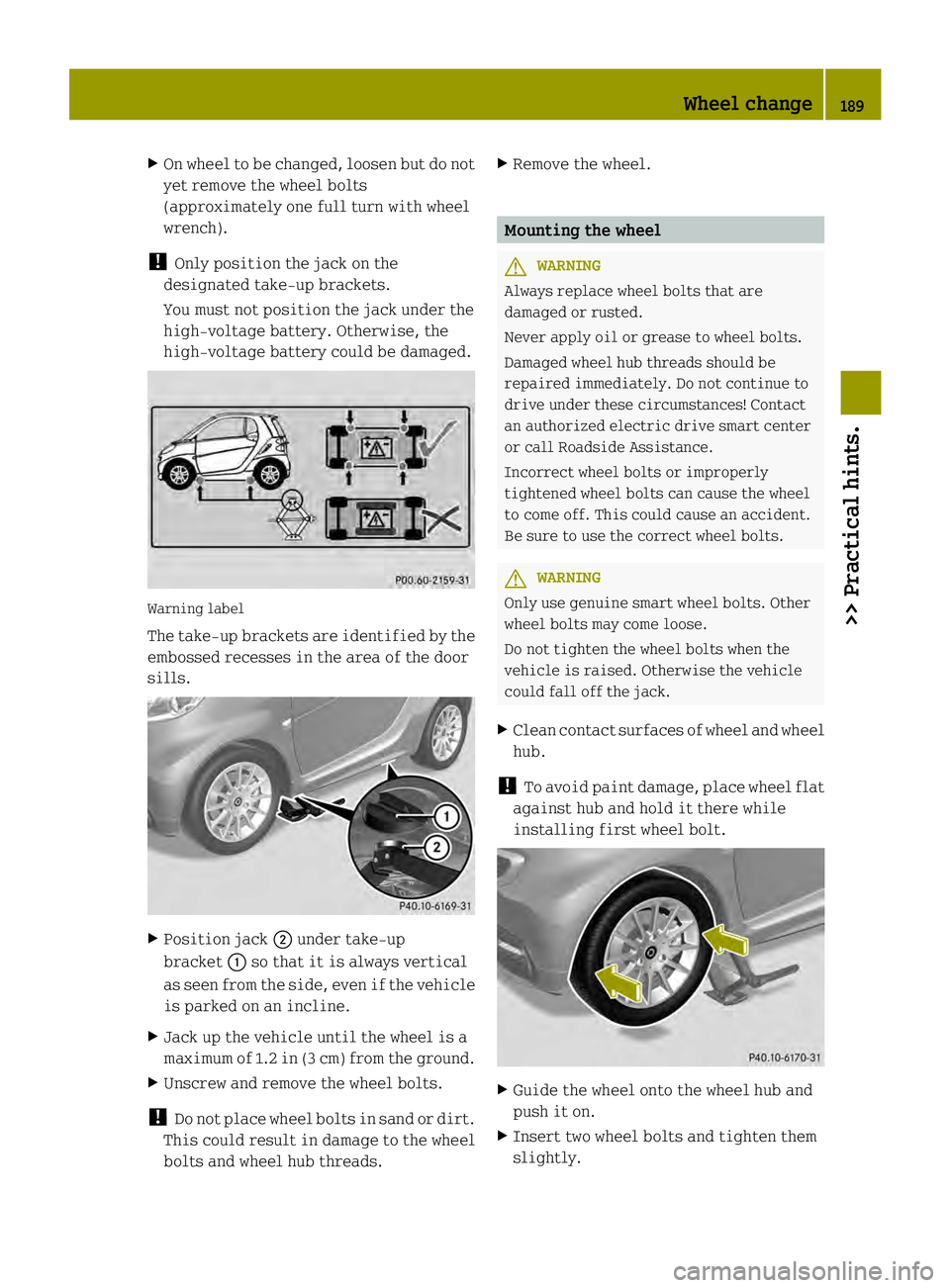
X
On wheel to be changed ,loosen but do not
yet remove the wheel bolts
(approximately one full turn with wheel
wrench).
! Only position the jack on the
designated take-up brackets.
You must not position the jack under the
high-voltage battery. Otherwise, the
high-voltage battery could be damaged. Warning label
The take-up brackets are identified by the
embossed recesses in the area of the door
sills. X
Position jack 0003under take-up
bracket 0002so that it is always vertical
as seen from the side, even if the vehicle
is parked on an incline.
X Jack up the vehicle until the wheel is a
maximum of 1.2 in (3 cm) from the ground.
X Unscrew and remove the wheel bolts.
! Do not place wheel bolts in sand or dirt.
This could result in damage to the wheel
bolts and wheel hub threads. X
Remove the wheel. Mounting the wheel
G
WARNING
Always replace wheel bolts that are
damaged or rusted.
Never apply oil or grease to wheel bolts.
Damaged wheel hub threads should be
repaired immediately. Do not continue to
drive under these circumstances! Contact
an authorized electric drive smart center
or call Roadside Assistance.
Incorrect wheel bolts or improperly
tightened wheel bolts can cause the wheel
to come off. This could cause an accident.
Be sure to use the correct wheel bolts. G
WARNING
Only use genuine smart wheel bolts. Other
wheel bolts may come loose.
Do not tighten the wheel bolts when the
vehicle is raised. Otherwise the vehicle
could fall off the jack.
X Clean contact surfaces of wheel and wheel
hub.
! To avoid paint damage, place wheel flat
against hub and hold it there while
installing first wheel bolt. X
Guide the wheel onto the wheel hub and
push it on.
X Insert two wheel bolts and tighten them
slightly. Wheel change
189>> Practical hints. Z